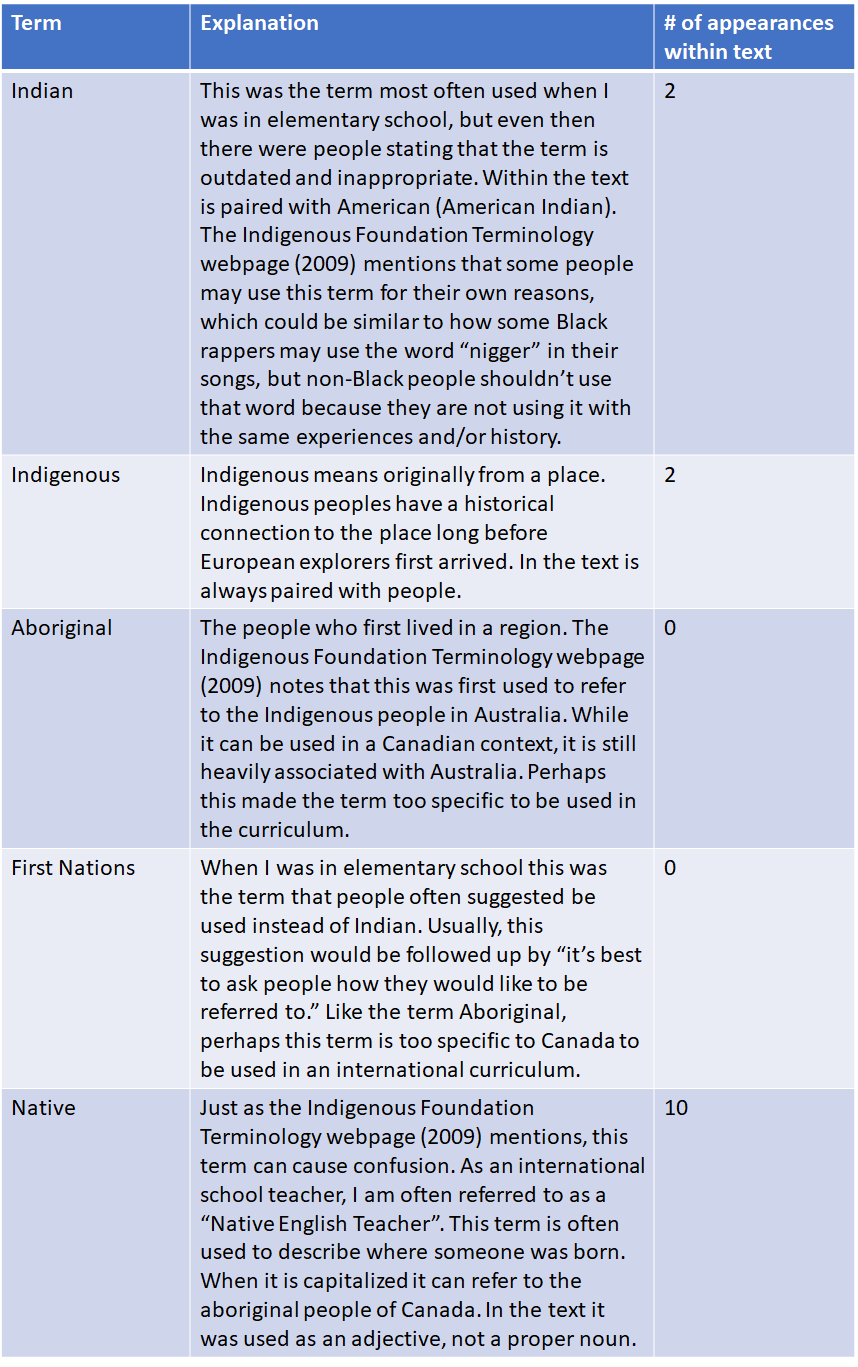- Text – ‘Explorers and Adventurers: Exploring the World’ is a 88-page curriculum guide from the International Primary Curriculum (IPC). IPC is a cross-curricular program “developed informed, globally competent, and future-ready learners” (Fieldwork Education, 2022). I chose their curriculum guide on this unit because my school uses IPC, it is my first year using this curriculum and as someone born and raised in Canada, I am curious how a British-designed program would approach the treatment of Indigenous people. This text is used by teachers to plan the unit, providing learning objectives, links to learning resources, guiding questions and suggested projects/activities. Although IPC is created in the UK and primarily used in the UK or English National Curriculum-based schools, the teachers implementing IPC objectives can be from all over the world, and would thus have different backgrounds and experiences regarding Indigeneity. The common thread guiding these teachers would be the curriculum guide. The impact of the explorers is mostly addressed in this IPC unit during Year 3 (Grade 2), which could be an indicator or an affecting agent on the prominence this part of history has on courses taken by pre-service teachers.
- Question: IPC always has a set of International learning goals for each year group. In ‘Explorers and Adventurers’, the International learning goals emphasized is: to “be able to research commonalities between different places and cultures” (Fieldwork Education, 2020, p. 13). How does the curriculum use this learning objective to create a deeper understanding and appreciation for Indigenous people and their culture among students and teachers?
- Search terms used were:
- Indian
- Indigenous
- Aboriginal
- First Nations
- Native
 Results: The learning objective is covered in 2 lessons out of a 6-week unit. Can a greater appreciation for Indigenous peoples’ cultures grow out of 2 lessons from a potential 30 lessons? The first lesson is an investigation of the positive and negative effects of exploration, where students research the advantages and disadvantages of exploring for their home countries or the host country. Students are asked to summarize their research by stating whether exploration has had “a largely positive or negative outcome for the world” (Fieldwork Education, 2020, p. 69). The second lesson focuses on female explorers and the rules that different cultures have for women.
Results: The learning objective is covered in 2 lessons out of a 6-week unit. Can a greater appreciation for Indigenous peoples’ cultures grow out of 2 lessons from a potential 30 lessons? The first lesson is an investigation of the positive and negative effects of exploration, where students research the advantages and disadvantages of exploring for their home countries or the host country. Students are asked to summarize their research by stating whether exploration has had “a largely positive or negative outcome for the world” (Fieldwork Education, 2020, p. 69). The second lesson focuses on female explorers and the rules that different cultures have for women.
4. New Question: Looking at the title of this unit, ‘Explorers and Adventurers: Exploring the World’, the unit brings to mind the glory and bravery often depicted in adventure stories. How does the curriculum balance the representation of the voices of the Indigenous people and explorers/adventurers?
5. New search term 1: I think explorer should be added because it can be used to frame how Indigenous people are viewed. Within the text there is a glossary that defines explorers as “someone who travels to places where no one has ever been in order to find out what Is
there” (Fieldwork Education, 2020, p. 80). At the beginning of the unit, the text suggests that explorers can be defined to the students as:
-
- people who want to extend our knowledge of the world around us
- a type of geographer
- people from the past that found new places (Fieldwork Education, 2020, p. 16).
New search term 2: adventurer should be added for the same reasons as explorer. The text-provided glossary defines adventurers as “someone who enjoys and looks for dangerous and exciting experiences” (Fieldwork Education, 2020, p. 80). It is suggested that teachers give the following explanations to students:
-
- Adventurers are thrill seekers who take risks
- Adventurers do things no one has done before (Fieldwork Education, 2020, p. 16)
Not including the title page and page headers, the term explorer was used 269 times and adventurer was used 44 times throughout the document.
6. Results: As indicated by the title and the number of times explorer and adventurer appeared is far more than all the five original search terms combined. It does not seem like the curriculum designers created this document with a balance of representation in mind.
Limitations of my searches: resources were linked to the terms, I skimmed the resource. Some of the video resources I was unable to access because they are only made available to British IP address holders, and the VPN I used is routed through Hong Kong.
Having said this, there were no resources suggested in the lesson about the impact of exploration. While there are more resources written from point of view of Indigenous peoples, it is still greatly outnumbered by the existing records and literature by Europeans. In the lesson about female explorers, the following explorers/adventurers to discuss were suggested: Dutch explorer Alexine Tinne, Englishwoman Mary Kingsley, American explorer Mary French Sheldon, British skipper Belinda Kirk, British kayaker Sarah Outen, the Afghan women’s cycling team and American Amelia Earhart. The goal of the lesson was to study contemporary women, but the lesson could have been extended or another lesson added to include women such as Sacagawea so students could learn that Indigenous women had an impact on history despite the restrictions placed on women during that time.
References
Fieldwork Education. (2020). Explorers and Adventurers: Exploring the World (2021-2027). Fieldwork Education Limited. https://fieldworkeducation.com/curriculums/primary-years
First Nations and Indigenous Studies: The University of British Columbia. (2009). Terminology. Indigenous Foundations. https://indigenousfoundations.arts.ubc.ca/terminology/